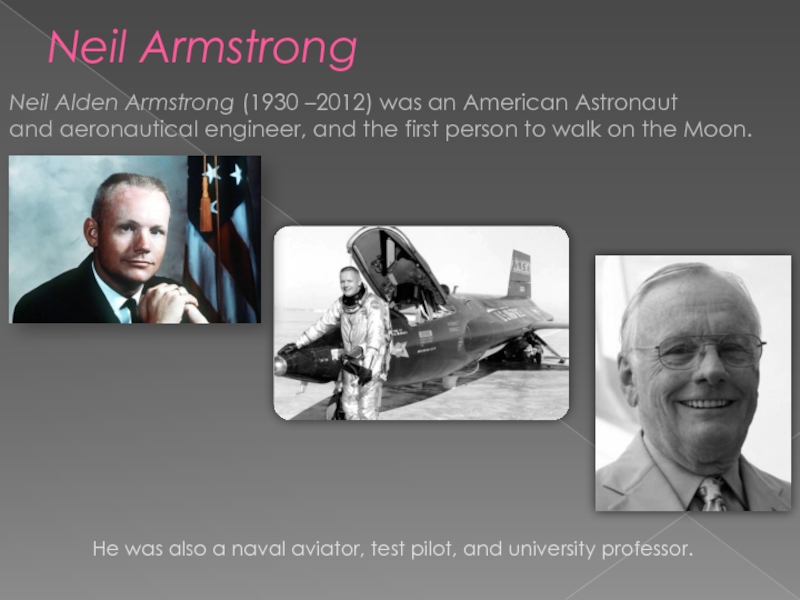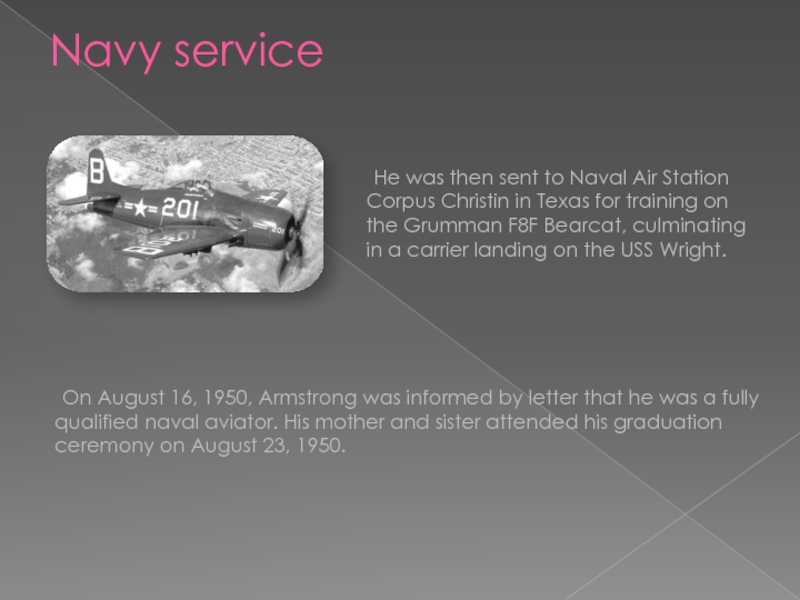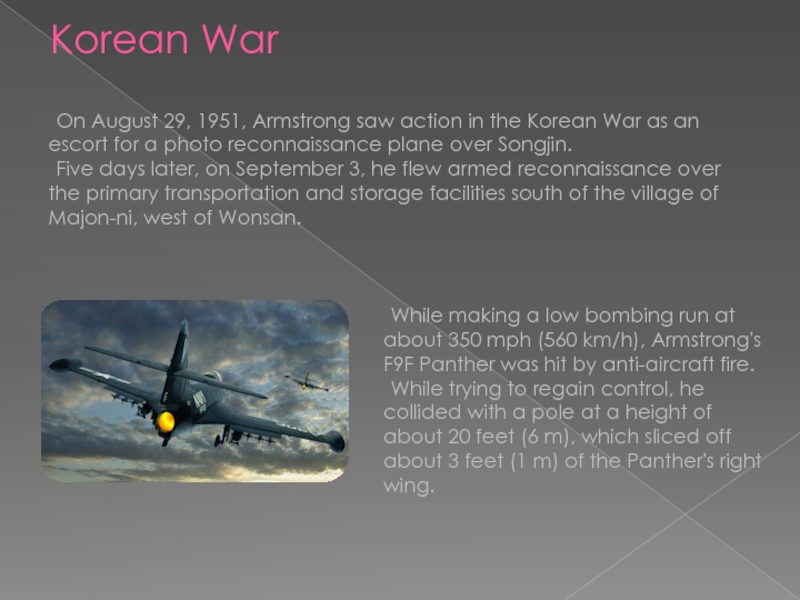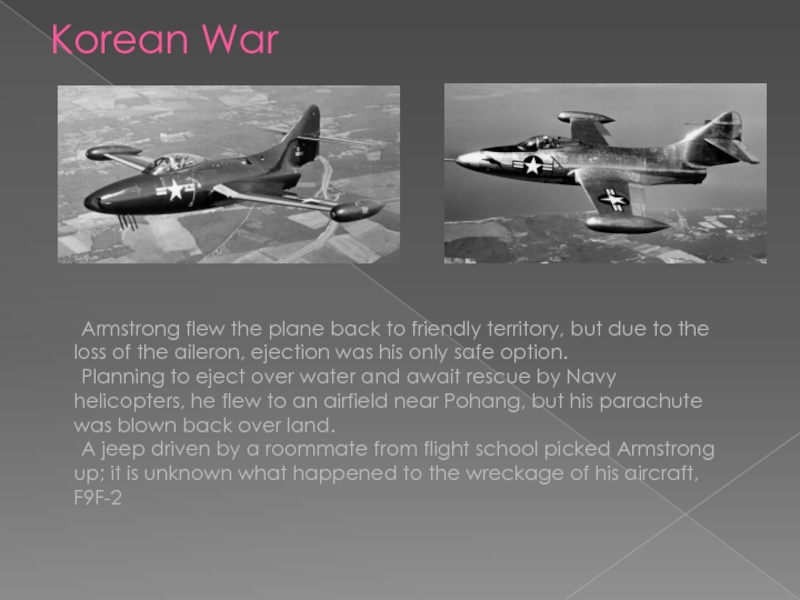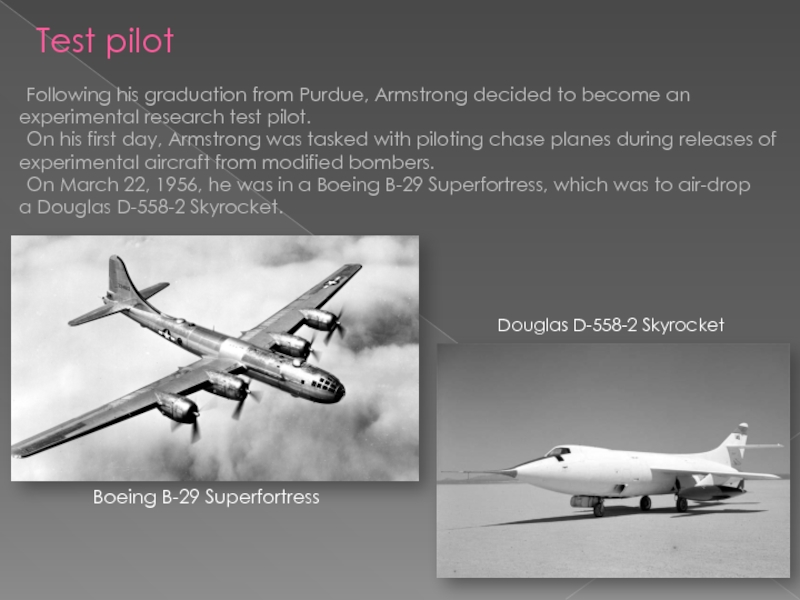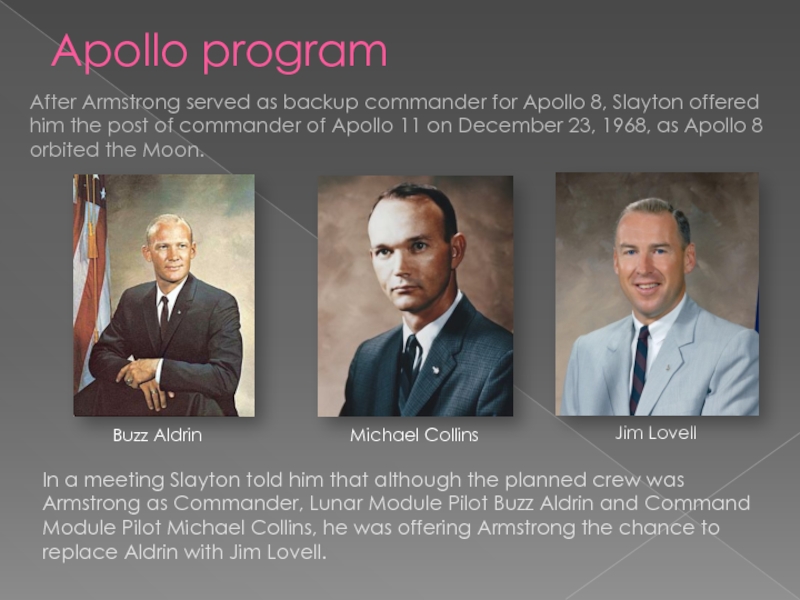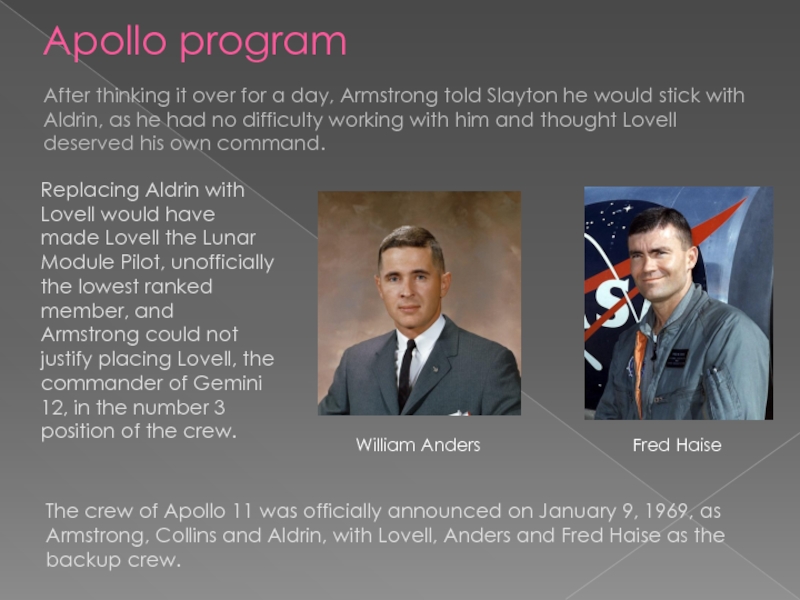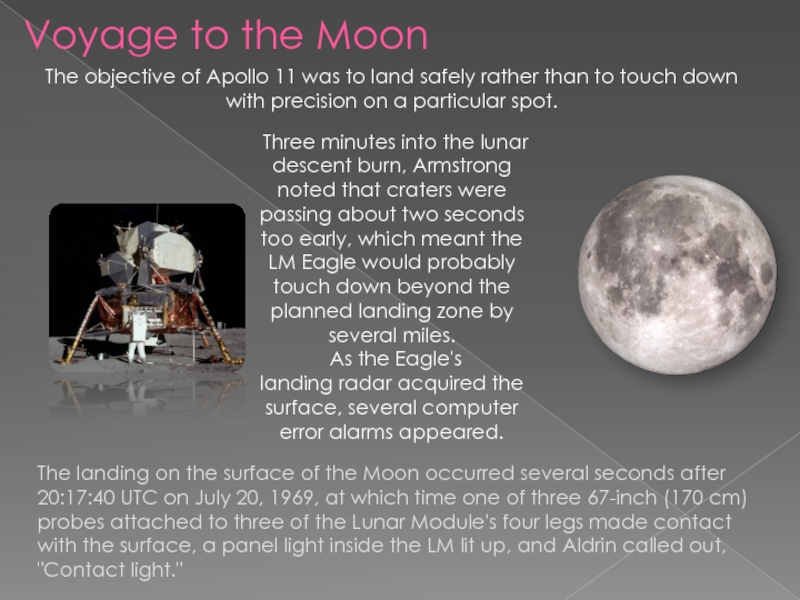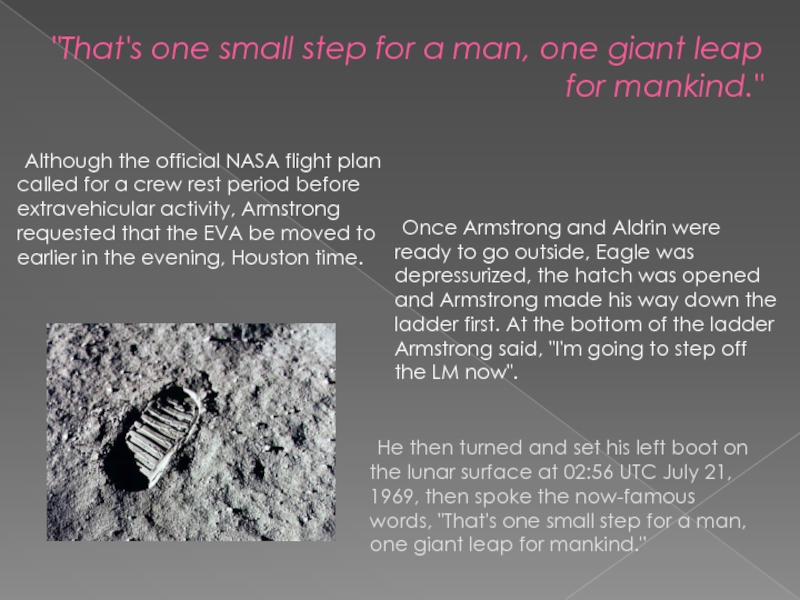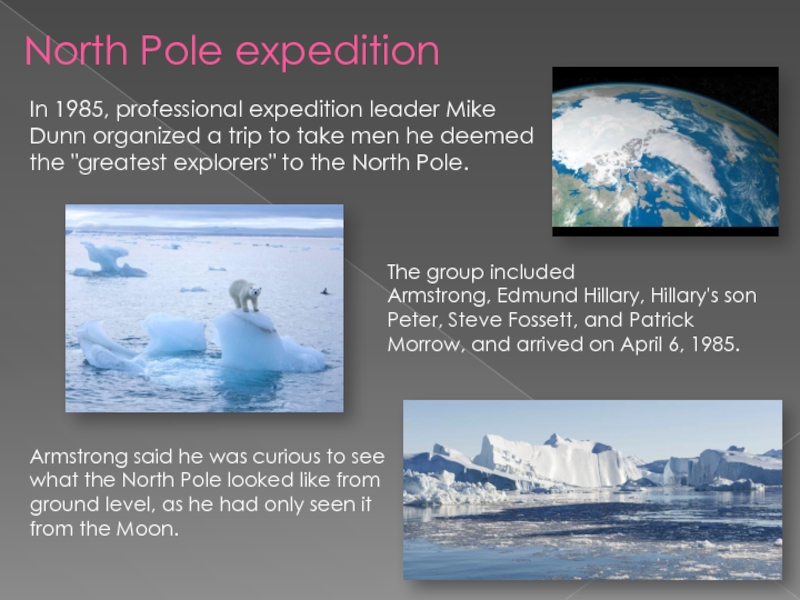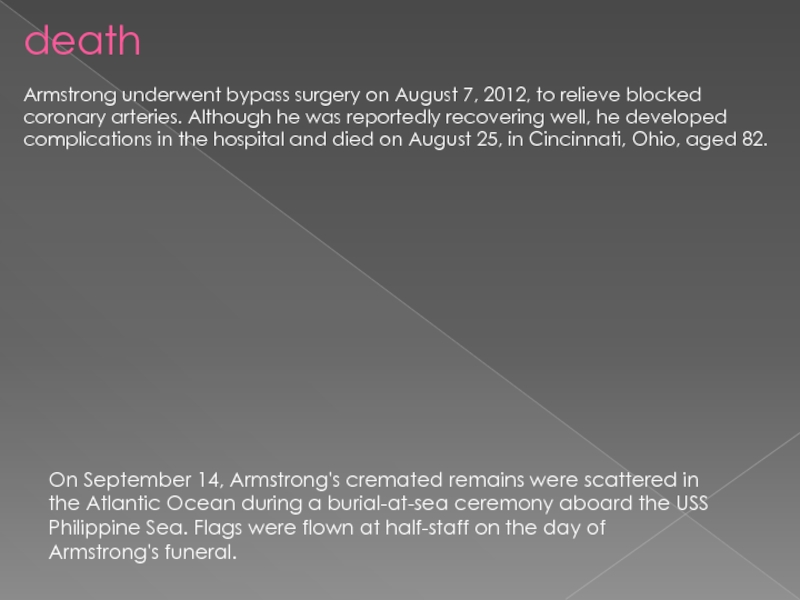Подготовил: Лемещенко Даниил 11АТ.
“Колледж Электроники и Приборостроения”
- Главная
- Разное
- Дизайн
- Бизнес и предпринимательство
- Аналитика
- Образование
- Развлечения
- Красота и здоровье
- Финансы
- Государство
- Путешествия
- Спорт
- Недвижимость
- Армия
- Графика
- Культурология
- Еда и кулинария
- Лингвистика
- Английский язык
- Астрономия
- Алгебра
- Биология
- География
- Детские презентации
- Информатика
- История
- Литература
- Маркетинг
- Математика
- Медицина
- Менеджмент
- Музыка
- МХК
- Немецкий язык
- ОБЖ
- Обществознание
- Окружающий мир
- Педагогика
- Русский язык
- Технология
- Физика
- Философия
- Химия
- Шаблоны, картинки для презентаций
- Экология
- Экономика
- Юриспруденция
Neil Armstrong презентация
Содержание
- 1. Neil Armstrong
- 2. Content of presentation: "That's one small step
- 3. Neil Armstrong Neil Alden Armstrong (1930 –2012)
- 4. Early years Armstrong was born on August
- 5. Early years Armstrong's love for flying grew
- 6. Navy service Armstrong's call-up from the Navy
- 7. Navy service He was then sent to Naval
- 8. Korean War On August 29, 1951, Armstrong
- 9. Korean War Armstrong flew the plane back
- 10. Following his graduation from Purdue, Armstrong decided
- 11. Armstrong and Butchart brought the aircraft into
- 12. Test pilot Butchart and Armstrong were forced
- 13. Astronaut career In June 1958, Armstrong was
- 14. Apollo program After Armstrong served as backup
- 15. Apollo program After thinking it over for
- 16. Voyage to the Moon The objective of
- 17. "That's one small step for a man,
- 18. Return to Earth The Eagle then continued to its
- 19. Teaching Armstrong announced shortly after the Apollo
- 20. Teaching He hoped that the faculty members
- 21. North Pole expedition In 1985, professional expedition
- 22. death Armstrong underwent bypass surgery on August
- 23. Glossary EVA - Extravehicular activity (внекорабельная деятельность)
- 24. Used: Wikipedia Yandex.Translate 24smi.org - Neil Armstrong Google Pictures The End
Слайд 1Famous person of USA: Neil Armstrong – the first man, who stepped
Слайд 2Content of presentation:
"That's one small step for a man, one giant
Neil Armstrong
Early Years
Navy Service
Korean War
Test Pilot
Astronaut career
Apollo program
Voyage to the Moon
Return to Earth
Teaching
North Pole expedition
death
Glossary
Used
Слайд 3Neil Armstrong
Neil Alden Armstrong (1930 –2012) was an American Astronaut and aeronautical engineer,
He was also a naval aviator, test pilot, and university professor.
Слайд 4Early years
Armstrong was born on August 5, 1930, near Wapakoneta, Ohio, the
He was of German, Irish and Scottish ancestry, and had a younger sister, June, and a younger brother, Dean.
His father worked as an auditor for the Ohio state government, and the family moved around the state repeatedly, living in 20 towns.
Слайд 5Early years
Armstrong's love for flying grew during this time, having started
Trimotor.
Слайд 6Navy service
Armstrong's call-up from the Navy arrived on January 26, 1949,
Flight training was conducted in a North American SNJ trainer, in which he soloed on September 9, 1949.On March 2, 1950, he made his first aircraft carrier landing on the USS Cabot, an event he considered comparable to his first solo flight.
Слайд 7Navy service
He was then sent to Naval Air Station Corpus Christin in
On August 16, 1950, Armstrong was informed by letter that he was a fully qualified naval aviator. His mother and sister attended his graduation ceremony on August 23, 1950.
Слайд 8Korean War
On August 29, 1951, Armstrong saw action in the Korean War as
Five days later, on September 3, he flew armed reconnaissance over the primary transportation and storage facilities south of the village of Majon-ni, west of Wonsan.
While making a low bombing run at about 350 mph (560 km/h), Armstrong's F9F Panther was hit by anti-aircraft fire.
While trying to regain control, he collided with a pole at a height of about 20 feet (6 m), which sliced off about 3 feet (1 m) of the Panther's right wing.
Слайд 9Korean War
Armstrong flew the plane back to friendly territory, but due
Planning to eject over water and await rescue by Navy helicopters, he flew to an airfield near Pohang, but his parachute was blown back over land.
A jeep driven by a roommate from flight school picked Armstrong up; it is unknown what happened to the wreckage of his aircraft, F9F-2
Слайд 10Following his graduation from Purdue, Armstrong decided to become an experimental
On his first day, Armstrong was tasked with piloting chase planes during releases of experimental aircraft from modified bombers.
On March 22, 1956, he was in a Boeing B-29 Superfortress, which was to air-drop a Douglas D-558-2 Skyrocket.
Boeing B-29 Superfortress
Douglas D-558-2 Skyrocket
Test pilot
Слайд 11Armstrong and Butchart brought the aircraft into a nose-down attitude to increase speed,
At the instant of launch, the number-four engine propeller disintegrated. Pieces of it damaged the number-three engine and hit the number-two engine.
As they ascended to 30,000 feet (9 km), the number-four engine stopped and the propeller began windmilling (rotating freely) in the airstream. Their aircraft needed to hold an airspeed of 210 mph (338 km/h) to launch its Skyrocket payload, and the B-29 could not land with the Skyrocket attached to its belly.
Test pilot
Слайд 12Test pilot
Butchart and Armstrong were forced to shut down the damaged
They made a slow, circling descent from 30,000 ft (9 km) using only the number-two engine, and landed safely.
Stanley P. Butchart
Слайд 13Astronaut career
In June 1958, Armstrong was selected for the U.S. Air
Ironically, as a NASA civilian test pilot, Armstrong was ineligible to become one of its astronauts at this time, as selection was restricted to military test pilots.
In November 1960, he was chosen as part of the pilot consultant group for the X-20 Dyna-Soar, a military space plane under development by Boeing for the U.S. Air Force, and on March 15, 1962, he was selected by the U.S. Air Force as one of seven pilot-engineers who would fly the X-20 when it got off the design board.
Слайд 14Apollo program
After Armstrong served as backup commander for Apollo 8, Slayton
In a meeting Slayton told him that although the planned crew was Armstrong as Commander, Lunar Module Pilot Buzz Aldrin and Command Module Pilot Michael Collins, he was offering Armstrong the chance to replace Aldrin with Jim Lovell.
Buzz Aldrin
Michael Collins
Jim Lovell
Слайд 15Apollo program
After thinking it over for a day, Armstrong told Slayton
The crew of Apollo 11 was officially announced on January 9, 1969, as Armstrong, Collins and Aldrin, with Lovell, Anders and Fred Haise as the backup crew.
Replacing Aldrin with Lovell would have made Lovell the Lunar Module Pilot, unofficially the lowest ranked member, and Armstrong could not justify placing Lovell, the commander of Gemini 12, in the number 3 position of the crew.
Fred Haise
William Anders
Слайд 16Voyage to the Moon
The objective of Apollo 11 was to land
Three minutes into the lunar descent burn, Armstrong noted that craters were passing about two seconds too early, which meant the LM Eagle would probably touch down beyond the planned landing zone by several miles.
As the Eagle's landing radar acquired the surface, several computer error alarms appeared.
The landing on the surface of the Moon occurred several seconds after 20:17:40 UTC on July 20, 1969, at which time one of three 67-inch (170 cm) probes attached to three of the Lunar Module's four legs made contact with the surface, a panel light inside the LM lit up, and Aldrin called out, "Contact light."
Слайд 17"That's one small step for a man, one giant leap for
Although the official NASA flight plan called for a crew rest period before extravehicular activity, Armstrong requested that the EVA be moved to earlier in the evening, Houston time.
Once Armstrong and Aldrin were ready to go outside, Eagle was depressurized, the hatch was opened and Armstrong made his way down the ladder first. At the bottom of the ladder Armstrong said, "I'm going to step off the LM now".
He then turned and set his left boot on the lunar surface at 02:56 UTC July 21, 1969, then spoke the now-famous words, "That's one small step for a man, one giant leap for mankind."
Слайд 18Return to Earth
The Eagle then continued to its rendezvous in lunar orbit, where
While preparing for the liftoff from the lunar surface, Armstrong and Aldrin discovered that, in their bulky spacesuits, they had broken the ignition switch for the ascent engine; using part of a pen, they pushed the circuit breaker in to activate the launch sequence.
After they re-entered the LM, the hatch was closed and sealed.
USS Hornet
Columbia, the Command and Service Module
Слайд 19Teaching
Armstrong announced shortly after the Apollo 11 flight that he did
He was appointed Deputy Associate Administrator for aeronautics for the Office of Advanced Research and Technology at ARPA, but served in this position for only a year, and resigned from it and NASA in 1971.
He accepted a teaching position in the Department of Aerospace Engineering at the University of Cincinnati, having decided on Cincinnati over other universities, including his alma mater, Purdue, because Cincinnati had a small aerospace department.
Слайд 20Teaching
He hoped that the faculty members would not be annoyed that
The official job title he received at Cincinnati was University Professor of Aerospace Engineering.
After teaching for eight years, he resigned in 1979 without explaining his reason for leaving.
Слайд 21North Pole expedition
In 1985, professional expedition leader Mike Dunn organized a
The group included Armstrong, Edmund Hillary, Hillary's son Peter, Steve Fossett, and Patrick Morrow, and arrived on April 6, 1985.
Armstrong said he was curious to see what the North Pole looked like from ground level, as he had only seen it from the Moon.
Слайд 22death
Armstrong underwent bypass surgery on August 7, 2012, to relieve blocked
On September 14, Armstrong's cremated remains were scattered in the Atlantic Ocean during a burial-at-sea ceremony aboard the USS Philippine Sea. Flags were flown at half-staff on the day of Armstrong's funeral.
Слайд 23Glossary
EVA - Extravehicular activity (внекорабельная деятельность)
Extravehicular activity is any activity done
NASA - The National Aeronautics and Space Administration
LM – Lunar Module
CM – Command Module


